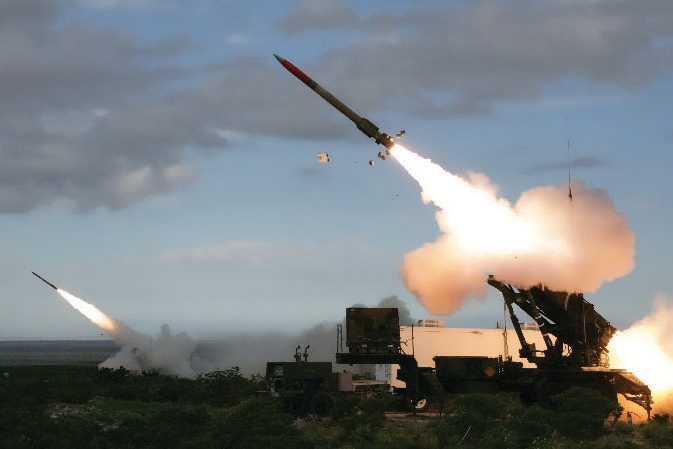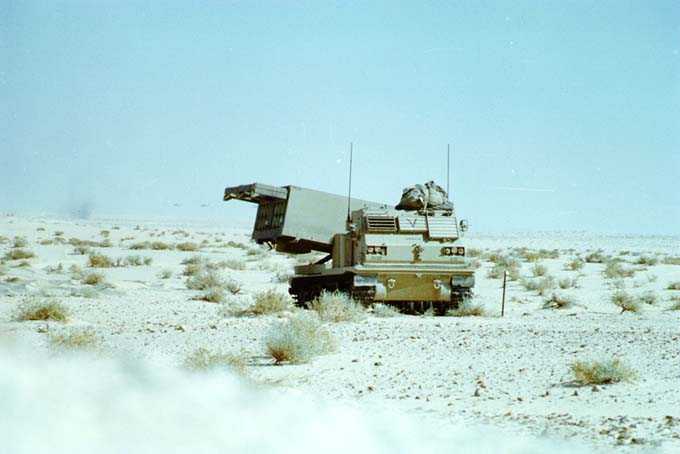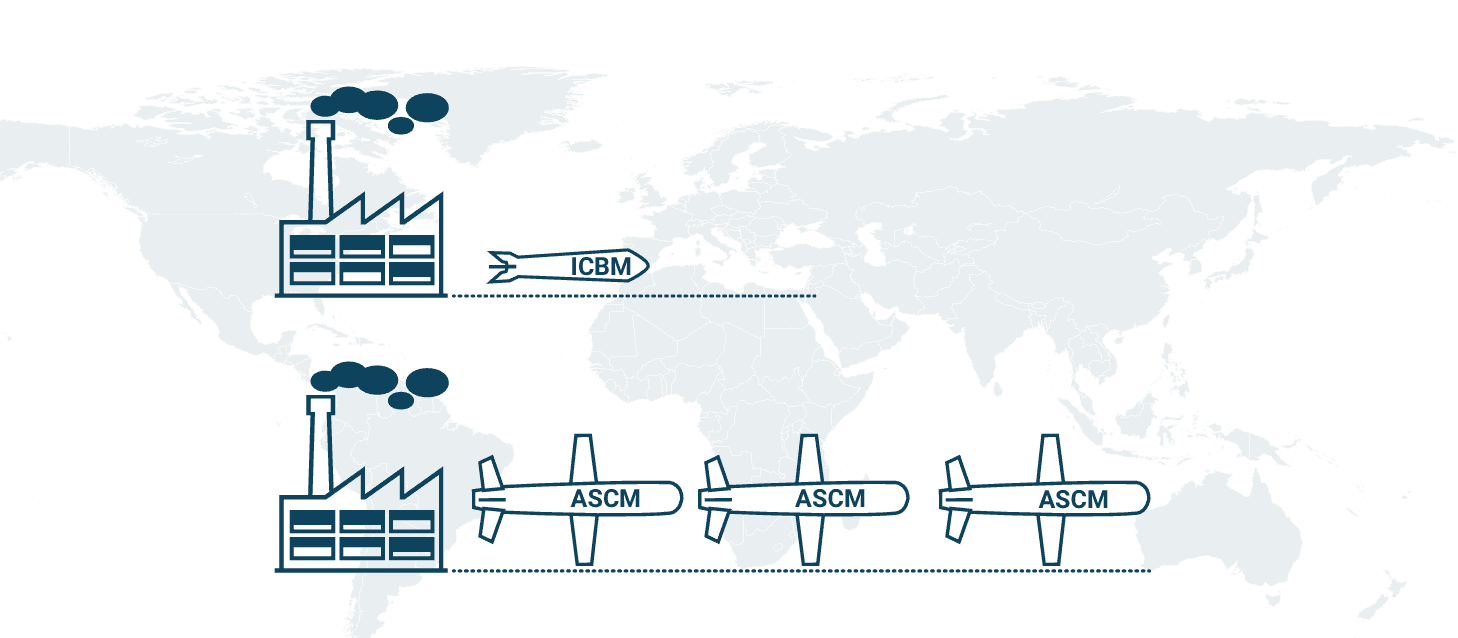Strategic considerations for missile procurement
Given the different types of missiles, what types of missiles are states most likely to procure? There is no easy answer to this, and it depends on a range of factors, most notably the exact requirements of the operator, the ability to manufacture the weapon system domestically or its availability on the international arms market, the availability of platforms for launching missiles, and relative costs, among others.
Importantly, every type of missile has distinct advantages and disadvantages. For example, ballistic missiles and boost-glide vehicles are ideal weapon systems for time-sensitive targets due to their low time-to-target, but comparatively expensive and difficult to manufacture. Subsonic cruise missiles can often provide the highest levels of accuracy while maintaining a stealthy approach. At the same time, they are rather slow and if they are detected, they are relatively easy to intercept. Long-range drones and rocket artillery constitute comparatively cheap and potentially more easily available options but may lack the survivability and yield necessary to reliably destroy their targets.
Therefore, states wanting to build up a formidable missile arsenal will ideally be able to procure a mix of missile capabilities, allowing them to flexibly choose in different scenarios. However, this will not be realistic for most states, given the budgetary constraints they face and/or their inability to procure the weapon system, even if they wanted to. This is either because they are unable to manufacture certain types of missiles at home or because they cannot buy them on the international arms market. In addition, states may lack access to certain platforms, such as surface vessels or aircraft, preventing them from deploying certain types of missiles, such as air-launched cruise missiles or submarine-launched ballistic missiles, for example.
As such, with the exception of a few powerful states that have significant financial, industrial and military resources to deploy large and diverse missile arsenals (arguably only the United States, China and potentially Russia, at present), most states will not be able to build the missile arsenals of their dreams. Instead, they will have to adapt their needs to the material realities within which they conduct their arms procurements.
Missile proliferation
Missiles have proliferated significantly since the end of the World War Two. 1 This has especially been the case since the end of the Cold War, and even more so in recent years. Reasons for this relate both to the demand side and the supply side of missile proliferation. On one hand, missiles provide enormous military utility for their possessor states both in conventional and nuclear warfare. On the other hand, missiles have become increasingly available due to a horizontalisation of missile manufacturing capabilities across the globe.
Demand side drivers
Supply side drivers
Missile defence
Although not the main focus of this learning unit, it is useful to briefly consider the requirements for effective missile defence, given that they directly relate to the characteristics of the types of missile capabilities outlined above. Further, it’s important to recognise that missile defence is not just a technical issue but also a deeply political one, especially considering its implications in the nuclear domain.
Modern missile defence systems consist of several elements. Typically, this includes a radar system that detects and potentially classifies incoming threats, the interceptor that engages incoming missile projectiles, one or several launcher units that launch said interceptors and a command and control unit that coordinates the missile defence engagement, for example by prioritising and allocating targets. Depending on the missile defence system, two or more of these elements may be integrated into one vehicle or combat station.


Depending on the type of missile threat the missile defence system is defending against, the set-up and capabilities of the missile defence system differ, especially in terms of the radar and the interceptor. Missile defence systems optimised to engage non-air-breathing threats, such as ballistic missiles, must be equipped with radars that can look high up into and potentially outside the atmosphere to detect and track incoming objects, and to guide an interceptor to the missile target. Given the trajectory of ballistic missiles, ballistic missile defence radars must be able to detect targets at high altitudes and at fairly long ranges.
In contrast, missile defence systems optimised for engaging air-breathing threats, such as cruise missiles, typically employ radars that scan for targets much closer to the ground, due to the relatively low altitude from which these threats approach. This means that the radar often has to deal with much more radar clutter, such as birds, treetops, buildings and terrain features that are not present at higher levels of the atmosphere. To overcome this, low-altitude radars employ clutter maps, mechanical and software-based filtering techniques, and narrow beam widths, among others. However, there are trade-offs between the radar’s ability to discriminate clutter and its range, limiting the distance at which low-altitude objects can be detected.
Given the longer range of engagement, interceptor missiles optimised for defending against high-altitude non-air-breathing threats are typically equipped with larger boosters and sometimes consist of several stages, similar to some types of ballistic missiles. These types of interceptors can also be equipped with a kill vehicle that separates from the booster to intercept the incoming missile threat, either by directly colliding with the projectile or by detonating a warhead. Depending on the range of the ballistic missile being engaged, interception may take place outside the atmosphere. In this case, late stage manoeuvring can be difficult for the interceptor due to the low atmospheric density. To retain the manoeuvrability necessary to successfully engage incoming missiles and RVs, thrust motors on the interceptor may be necessary. In contrast, interceptors optimised to engage air-breathing threats are usually single stage, employ fragmentation warheads and rely on aerodynamic control surfaces for manoeuvring, which is feasible due to the higher atmospheric density at lower altitudes.
The important thing to remember is that the flight profile and characteristics of the missile system matter for missile defence. Moreover, given the different requirements for distinct types of missiles, not every type of missile defence system will be able to deal with every type of missile threat. This is why analysts typically talk about the need to deploy layered missile defence systems whereby different types of missile defence capabilities defend a target area together.2
For example, if a state only deploys missile defence systems optimised to defend against non-air-breathing threats such as ballistic missiles, the defended area may still be vulnerable to air-breathing threats, such as cruise missiles. In addition, the attacker might be able to attack and destroy the ballistic missile defence system with a cruise missile, and can subsequently attack the target area again with ballistic missiles and other types of non-air-breathing threats. Different types of missile defence systems must therefore not only coordinate to defend a certain target area, but also to defend one another against distinct types of missile threats.
As outlined above, missile defence has always had a strong political dimension, especially within the context of nuclear strategy. During the Cold War, ballistic missile defence was often seen as an offensive capability. This perception stemmed from the potential for such systems to enable a nuclear first strike by intercepting and neutralising an adversary’s remaining nuclear weapons after an initial attack, thereby undermining the assured second-strike capability of a nuclear-armed state.
In response, the United States and the Soviet Union signed the Anti-Ballistic Missile (ABM) Treaty in 1972 (see also LU20). This treaty limited each superpower to two missile defence complexes each, with no more than 100 interceptors deployed – an amount deemed insufficient to threaten the adversary’s assured retaliatory capability. While the Soviet Union decided to place their system near Moscow, the US placed theirs near an ICBM base not far from Grand Forks, North Dakota.
Locations of a Soviet and American anti-ballistic missile station
Placement of the missile defence systems agreed in the ABM Treaty during the Cold War
Data: Natual Earth. Graphic: PRIF
Despite this agreement, strategic missile defence remained controversial.3 Thirty years after the treaty was signed, the George W. Bush administration withdrew from the ABM Treaty, citing a growing ballistic missile threat from “rogue actors” such as Iran and North Korea.
Missile defence has since been a contentious issue in NATO-Russia and US-China relations. China and Russia accuse the United States and its European and Asian allies of undermining strategic stability by increasing their missile defence capabilities, especially in combination with other types of advanced non-nuclear technologies. 4 Conversely, the United States and its partners argue that these deployments are essential due to the rising conventional missile threat from various actors, most notably China and Russia.
Footnotes
-
Fabian Hoffmann, Cruise Missile Proliferation: Trends, Strategic Implications, and Counterproliferation (London: European Leadership Network, 2021), https://www.europeanleadershipnetwork.org/wp-content/uploads/2021/03/Fabian_Final-2.pdf ↩
-
The Strategic Implications of Layered Missile Defence, Strategic Comments (London: International Institute for Strategic Studies, 2021), https://www.iiss.org/en/publications/strategic-comments/2021/layered-missile-defence/ ↩
-
Andrew Futter and Benjamin Zala, “Advanced Conventional Weapons and Nuclear Disarmament: Why the Obama Plan Didn’t Work,” The Nonproliferation Review 20, no. 1 (2013): 107-122, https://doi.org/10.1080/10736700.2012.761790. ↩
-
Tong Zhao,”Conventional Long-Range Strike Weapons of US Allies and China’s Concerns of Strategic Instability,” The Nonproliferation Review 27, no. 1–3 (2020), 109–22, https://www.tandfonline.com/doi/full/10.1080/10736700.2020.1795368 ↩



